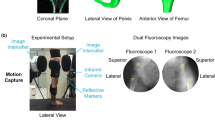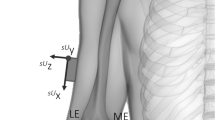Abstract
There is growing evidence that femoroacetabular impingement (FAI) is a probable risk factor for the development of early osteoarthritis in the nondysplastic hip. As FAI arises with end range of motion activities, measurement errors related to skin movement might be higher than anticipated when using previously reported methods for kinematic evaluation of the hip. We performed an in vitro validation and reliability study of a noninvasive method to define pelvic and femur positions in end range of motion activities of the hip using an electromagnetic tracking device. Motion data, collected from sensors attached to the bone and skin of 11 cadaver hips, were simultaneously obtained and compared in a global reference frame. Motion data were then transposed in the hip joint local coordinate systems. Observer-related variability in locating the anatomical landmarks required to define the local coordinate system and variability of determining the hip joint center was evaluated. Angular root mean square (RMS) differences between the bony and skin sensors averaged 3.2° (SD 3.5°) and 1.8° (SD 2.3°) in the global reference frame for the femur and pelvic sensors, respectively. Angular RMS differences between the bony and skin sensors in the hip joint local coordinate systems ranged at end range of motion and dependent on the motion under investigation from 1.91 to 5.81°. The presented protocol for evaluation of hip motion seems to be suited for the 3-D description of motion relevant to the experimental and clinical evaluation of femoroacetabular impingement.

Similar content being viewed by others
References
An KN, Jacobsen MC, Berglund LJ, Chao EY (1988) Application of a magnetic tracking device to kinesiologic studies. J Biomech 21:613–620
Begon M, Monnet T, Lacouture P (2007) Effects of movement for estimating the hip joint centre. Gait Posture 25:353–359
Bell AL, Pedersen DR, Brand RA (1990) A comparison of the accuracy of several hip center location prediction methods. J Biomech 23:617–621
Chegini S, Beck M, Ferguson SJ (2009) The effects of impingement and dysplasia on stress distributions in the hip joint during sitting and walking: a finite element analysis. J Orthop Res 27:195–201
Day JS, Murdoch DJ, Dumas GA (2000) Calibration of position and angular data from a magnetic tracking device. J Biomech 33:1039–1045
Flanagan S, Salem GJ, Wang MY, Sanker SE, Greendale GA (2003) Squatting exercises in older adults: kinematic and kinetic comparisons. Med Sci Sports Exerc 35:635–643
Ganz R, Leunig M, Leunig-Ganz K, Harris WH (2008) The etiology of osteoarthritis of the hip: an integrated mechanical concept. Clin Orthop Relat Res 466:264–272
Ganz R, Parvizi J, Beck M, Leunig M, Notzli H, Siebenrock KA (2003) Femoroacetabular impingement: a cause for osteoarthritis of the hip. Clin Orthop Relat Res 417:112–120
Gilles B, Christophe FK, Magnenat-Thalmann N et al (2009) MRI-based assessment of hip joint translations. J Biomech 42:1201–1205
Groscurth P, Eggli P, Kapfhammer J, Rager G, Hornung JP, Fasel JD (2001) Gross anatomy in the surgical curriculum in Switzerland: improved cadaver preservation, anatomical models, and course development. Anat Rec 265:254–256
Gutschow M, Heinecke K, Thiel W, Leistner S (1991) Polycyclic azines with heteroatoms in the 1- and 3-position. 30. Synthesis of 6,7-dimethoxy-substituted 3,1-benzothiazin-4-ones. Arch Pharm (Weinheim) 324:465–466
Hemmerich A, Brown H, Smith S, Marthandam SS, Wyss UP (2006) Hip, knee, and ankle kinematics of high range of motion activities of daily living. J Orthop Res 24:770–781
Hicks JL, Richards JG (2005) Clinical applicability of using spherical fitting to find hip joint centers. Gait Posture 22:138–145
Kobayashi K, Gransberg L, Knutsson E, Nolén P (1997) A new system for three-dimensional gait recording using electromagnetic tracking. Gait Posture 6(1):63–75
Lamontagne M, Kennedy MJ, Beaule PE (2009) The effect of cam FAI on hip and pelvic motion during maximum squat. Clin Orthop Relat Res 467:645–650
Leardini A, Cappozzo A, Catani F et al (1999) Validation of a functional method for the estimation of hip joint centre location. J Biomech 32:99–103
Meskers CG, Fraterman H, van der Helm FC, Vermeulen HM, Rozing PM (1999) Calibration of the “flock of birds” electromagnetic tracking device and its application in shoulder motion studies. J Biomech 32:629–633
Meskers CG, Vermeulen HM, de Groot JH, van der Helm FC, Rozing PM (1998) 3D shoulder position measurements using a six-degree-of-freedom electromagnetic tracking device. Clin Biomech (Bristol, Avon) 13:280–292
Milne AD, Chess DG, Johnson JA, King GJ (1996) Accuracy of an electromagnetic tracking device: a study of the optimal range and metal interference. J Biomech 29:791–793
Myers SR, Eijer H, Ganz R (1999) Anterior femoroacetabular impingement after periacetabular osteotomy. Clin Orthop Relat Res 363:93–99
Piazza SJ, Okita N, Cavanagh PR (2001) Accuracy of the functional method of hip joint center location: effects of limited motion and varied implementation. J Biomech 34:967–973
Saber-Sheikh K, Bryant EC, Glazzard C, Hamel A, Lee RY (2010) Feasibility of using inertial sensors to assess human movement. Man Ther 15(1):122–125
Sprigle S, Wootten M, Bresler M, Flinn N (2002) Development of a noninvasive measure of pelvic and hip angles in seated posture. Arch Phys Med Rehabil 83:1597–1602
Tanzer M, Noiseux N (2004) Osseous abnormalities and early osteoarthritis: the role of hip impingement. Clin Orthop Relat Res 429:170–177
Thiel W (1992) The preservation of the whole corpse with natural color. Ann Anat 174:185–195
Thomas JS, Gibson GE (2007) Coordination and timing of spine and hip joints during full body reaching tasks. Hum Mov Sci 26:124–140
Wu G, Siegler S, Allard P et al (2002) ISB recommendation on definitions of joint coordinate system of various joints for the reporting of human joint motion–part I: ankle, hip, and spine. International society of biomechanics. J Biomech 35:543–548
Yamamura M, Miki H, Nakamura N, Murai M, Yoshikawa H, Sugano N (2007) Open-configuration MRI study of femoro-acetabular impingement. J Orthop Res 25:1582–1588
Acknowledgments
The presented work was in part supported by Materialise NV and the Institute for the Promotion of Innovation through Science and Technology in Flanders (IWT-Vlaanderen).
Author information
Authors and Affiliations
Corresponding author
Rights and permissions
About this article
Cite this article
Audenaert, E.A., Vigneron, L., Van Hoof, T. et al. In vitro validation and reliability study of electromagnetic skin sensors for evaluation of end range of motion positions of the hip. Med Biol Eng Comput 49, 1405–1412 (2011). https://doi.org/10.1007/s11517-011-0804-5
Received:
Accepted:
Published:
Issue Date:
DOI: https://doi.org/10.1007/s11517-011-0804-5




